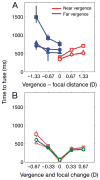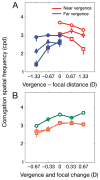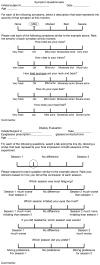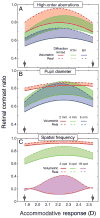Vergence-accommodation conflicts hinder visual performance and cause visual fatigue
- PMID: 18484839
- PMCID: PMC2879326
- DOI: 10.1167/8.3.33
Vergence-accommodation conflicts hinder visual performance and cause visual fatigue
Abstract
Three-dimensional (3D) displays have become important for many applications including vision research, operation of remote devices, medical imaging, surgical training, scientific visualization, virtual prototyping, and more. In many of these applications, it is important for the graphic image to create a faithful impression of the 3D structure of the portrayed object or scene. Unfortunately, 3D displays often yield distortions in perceived 3D structure compared with the percepts of the real scenes the displays depict. A likely cause of such distortions is the fact that computer displays present images on one surface. Thus, focus cues-accommodation and blur in the retinal image-specify the depth of the display rather than the depths in the depicted scene. Additionally, the uncoupling of vergence and accommodation required by 3D displays frequently reduces one's ability to fuse the binocular stimulus and causes discomfort and fatigue for the viewer. We have developed a novel 3D display that presents focus cues that are correct or nearly correct for the depicted scene. We used this display to evaluate the influence of focus cues on perceptual distortions, fusion failures, and fatigue. We show that when focus cues are correct or nearly correct, (1) the time required to identify a stereoscopic stimulus is reduced, (2) stereoacuity in a time-limited task is increased, (3) distortions in perceived depth are reduced, and (4) viewer fatigue and discomfort are reduced. We discuss the implications of this work for vision research and the design and use of displays.
Figures















References
-
- Akeley K, Watt SJ, Girshick AR, Banks MS. A stereo display prototype with multiple focal distances. ACM Transactions on Graphics. 2004;23:804–813.
-
- Backus BT, Banks MS. Estimator reliability and distance scaling in stereoscopic slant perception. Perception. 1999;28:217–242. - PubMed
-
- Backus BT, Banks MS, van Ee R, Crowell JA. Horizontal and vertical disparity, eye position, and stereoscopic slant perception. Vision Research. 1999;39:1143–1170. - PubMed
-
- Baird JC, Biersdorf WR. Quantitative functions for size and distance judgments. Perception & Psychophysics. 1967;2:161–166.
Publication types
MeSH terms
Grants and funding
LinkOut - more resources
Full Text Sources
Other Literature Sources

